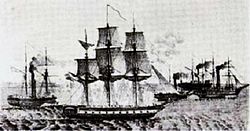Valkyrien (ship, 1846)
|
The Valkyrien (front) in the sea battle near Helgoland
|
||||||||||||||||||||
|
||||||||||||||||||||
|
||||||||||||||||||||
|
||||||||||||||||||||
|
||||||||||||||||||||
The Valkyrien was a corvette of the Royal Danish Navy , which took part in the naval battle near Helgoland on June 4, 1849 , but was used as a cadet training ship for most of its service life .
Construction and technical data
The three-masted, as a full-rigged ship rigged ship was on the Orlogsværftet (War shipyard) in Copenhagen , designed by Andreas Schifter built and ran there on June 11 in 1846 by stack . It was 39.23 m long and 9.98 m wide, had a 4.60 m draft and was measured with 331 Danish loads (Læster). Its armament consisted of 20 × 18 pounder cannons and six × 4 pounder howitzers .
Mission history
The Valkyrien was put into service on May 1, 1847 and was then on test and training trips until September 20, 1847. On January 4, 1948, she went on a eleven-month trip to the front and rear-India , from which they returned on December 2, 1848th When the constitutional crisis surrounding the two duchies of Schleswig and Holstein threatened to escalate into open revolt soon afterwards , the Valkyrien was also made ready for war. It was deployed from March 8 to November 3, 1849 and then again from March 25, 1850 to January 24, 1851, mostly with the North Sea Squadron to block the German North Sea ports.
It came on June 4, 1849 naval battle at Helgoland , when the Wesermündung blocking Valkyrien by a small squadron of the newly created German Empire fleet consisting of the steam frigate Barbarossa and steam corvettes Luebeck and Hamburg , under Captain Karl Rudolf Brommy was attacked . The Valkyrien , under the command of Kaptajn Andreas C. Polder, withdrew near what was then the British island of Helgoland . There she received support from the wheeled corvette Gejser who had rushed up, and Brommy broke off the action when he saw two more Danish frigates approaching the field of battle.
After the end of the war, the Valkyrien served as a cadet training ship from May 1, 1852 to the end of 1863, and was laid up and overhauled in winter. Another military service followed for a short time from May 17 to June 25, 1864 during the German-Danish War . Then the Valkyrien sailed again for a year, from July 8, 1864 to August 15, 1865, as a cadet training ship.
On November 19, 1867, she was struck from the list of ships, withdrawn on March 11, 1871 and then canceled.
Footnotes
- ↑ 1779–1852, Danish ship designer, “Master Shipbuilder” in the Danish Navy from 1814 to 1846, lastly Vice Admiral .
- ↑ A load was about 2.6 tons ( https://sizes.com/units/laest.htm ).

